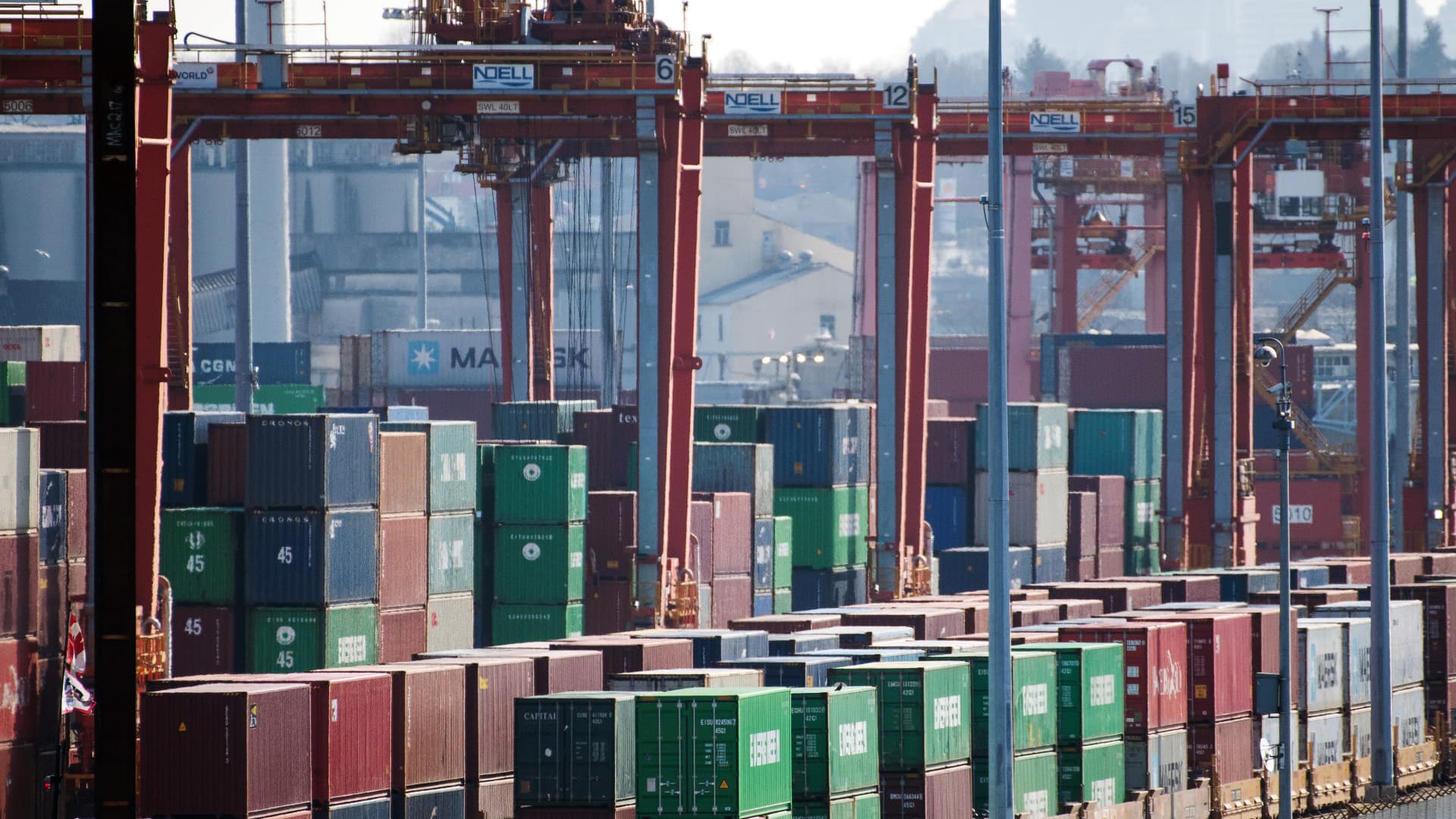Shipping containers are loaded onto rail cars at the Global Container Terminals Vanterm container terminal on Vancouver Harbour in Vancouver, British Columbia, Canada.
Bloomberg | Bloomberg | Getty Images
Members of the International Longshore and Warehouse Union (ILWU) of Canada voted to ratify the second tentative agreement with West Coast port ownership, meaning an end to the uncertainty and trade congestion that has gripped the supply chain for weeks since dock workers first decided to strike.
Rob Ashton, president of the ILWU, said 74.66% of members voted in favor of accepting the terms of the tentative agreement.
The ILWU Canada and the British Columbia Maritime Employers Association (BCMEA) announced a revised second tentative deal last Sunday, with the agreement brokered by the Canada Industrial Relations Board, after union members rejected an original deal proposal. The country’s industrial relations board directed the union to vote no later than Friday.
The new deal includes increases in wages, benefits, and training, according to an overnight statement by the BCMEA. No additional specifics were given.
The original deal proposal which was rejected increased the compounded wage over four years by 19.2%, according to disclosures from the BCMEA, as well as a signing bonus of $1.48 an hour per employee, which tallied to approximately $3,000 per full-time worker. There was also an 18.5% increase in the retirement payout.
The union argued that worker salaries were unsustainable against rising inflation, but the BCMEA countered that over the past 13 years, longshore wages have risen by 40%, ahead of inflation at 30%. The union said that the use of contract labor for maintenance work was another sticking point in the deal.
The BCMEA said the ratification would provide “certainty and stability for the future of Canada’s West Coast ports.”
“The BCMEA recognizes and regrets the profound repercussions this labor disruption has had on the national economy, workers, businesses and ultimately, all Canadians that depend on an efficient and reliable supply chain. All supply chain stakeholders must collaborate now to ensure we do not see disruptions like this ever again.”
But, after a week of traveling and meeting shipping clients, Paul Brashier, vice president of drayage at ITS Logistics, told CNBC the reliability and reputation of the Canadian ports have created lasting damage.
“We are happy that the ILWU has finally come to terms and agreed to a new contract,” said Brashier. “Unfortunately, this lack of government intervention and direction has forced cargo owners and shippers in our network to make the decision and permanently move their imports back to the U.S. port of entry on the West Coast.”
Over the course of the 14-day strike, ocean carriers either pulled up anchor to divert the Canadian ports to stay on schedule and unload at U.S. ports. Some U.S. shippers reconsigned the destination of their containers to the U.S during that time. Other ocean carriers eventually went back to the Canadian ports and waited to unload both Canadian and U.S. freight.
Canadian Labor Minister Seamus O’Regan tweeted acknowledgment of the supply chain damage the strikes caused and is now calling on federal officials to review how the disruption of this magnitude unfolded so it can be avoided in the future.
Supply chain delays will last months
It will take at least two months for the railroads to clear out the pileup of containers as a result of the 14 days of striking by dock workers. At the height of the strike, $12 billion in freight was stranded on the water. Some of that trade was diverted on vessels that called on ports on the U.S. West Coast.
The Railway Association of Canada originally estimated that it would take three to five days, for every day the strike lasted, for networks and supply chains to recover. When the first strike ended on its 13th day, delays for rail containers were estimated at 39 to 66 days. After an additional day of work stoppage in the on-again, off-again strike, the congestion tally moved up to a range of 42 to 70 days.
“Delays appear to be bearing out toward the mid-to-upper end of that range,” a Railway Association of Canada spokesperson recently told CNBC via email.
Changes to vessel routes impact the profitability of railroads, including Canadian Pacific Kansas City and Canadian National Railway, since fewer containers can be unloaded at U.S. ports. This decrease in containers also impacts trucking companies. On the flip side, the extra containers coming into U.S. ports will add to the profitability of U.S. trucking companies and railroads BNSF, a subsidiary of Berkshire Hathaway, and Union Pacific. Over the long term, if Canadian trade is rerouted to the East Coast as a result of West Coast labor strife, that would also benefit Norfolk Southern and CSX.
In the first two weeks of the strike, the flow of railroad trade from Canada to the U.S. was cut by 82%. Train trade has slowly recovered, with a 6.2% decrease being tabulated for the week ending July 29.
The supply chain issues have already hit the bottom lines of railroad companies. Canadian Pacific Kansas City railroad’s chief marketing officer John Brooks told analysts on the company’s conference call last week the labor unrest will negatively impact the railroad’s revenue by $80 million. Brooks said the company is working to claw back those losses over the third and fourth quarters.
Canadian National Railway announced it was running additional trains to help expedite the clearing out of the container congestion.
The timing of this strike occurred during the peak shipping season, when back-to-school and holiday items are arriving for retailers.
